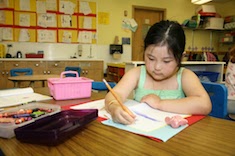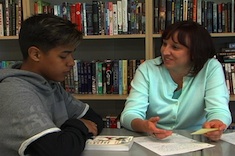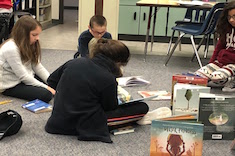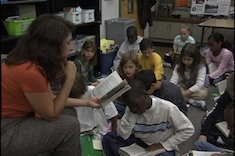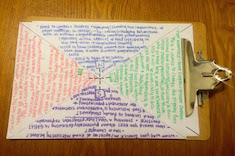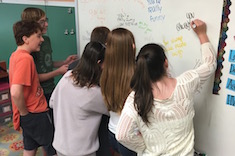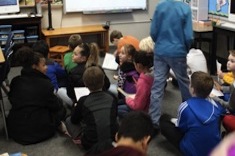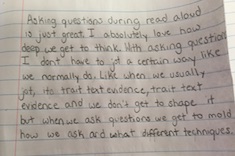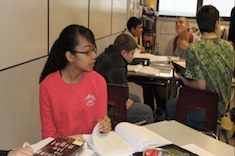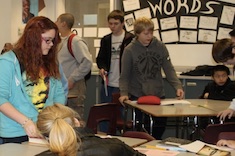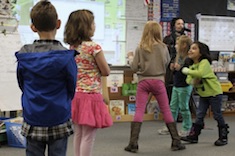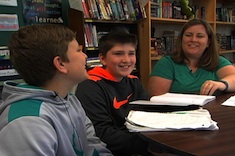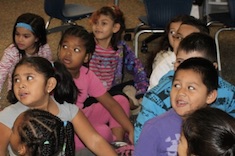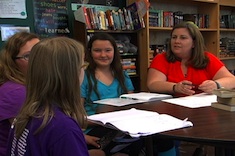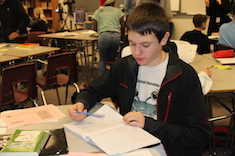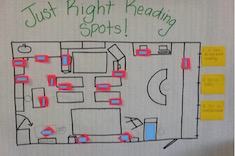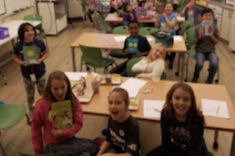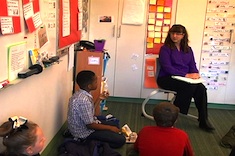Community Building
It's one of the big paradoxes of literacy instruction - students best learn how to read and write independently when they have a strong community of support in classrooms. How teachers build those thoughtful, kind, and challenging classroom communities is explained in these resources.
Latest Content
Does the Pencil Still Have Power?
Ruth Ayres wonders if the pencil still has power, taking readers through a whirlwind history of the writing tool in her life, schools, and the world.
Building Routines
Bitsy Parks teaches the foundations of first-grade classroom life through minilessons early in the year.
Getting to Know Each Other Through the Work
Mark Levine explains why he dives right into work in his middle school classroom, rather than getting-to-know-you activities. And through the work, a community is born.
Seeking Personal Relevance
Christy Rush-Levine has to figure out how to engage a class of students that is compliant and dutiful, but shows little passion for reading and writing.
Invitations vs. Accountability
It’s not an invitation if students are required to accept it. Franki Sibberson explains how engagement depends upon true choice and lots of options in her fifth-grade classroom.
The Year’s First Read Aloud
From length to heart, Tara Smith provides seven criteria for selecting the first read aloud of the year that can engage students right from the start.
Compass Points and Empathy
Andrea Smith uses the “compass points” strategy to provoke better whole-class discussions and reflection during read alouds.
My World Maps
Creating “world” maps is a great way to explore the territories beyond school that matter most to everyone in your classroom. Suzy Kaback explains how to create them with students early in the year as a way to get to know them as learners and community members.
Spreading Love with Compliments
Tara Barnett and Kate Mills close out the year in their eighth-grade classroom with a compliments activity.
Looking Forward with Students
Melanie Meehan uses reflective questions and video to build a library of materials at the end of the year to use with next year's class.
Literacy and Global Competence
“China is going to kill us all!” This quote from a student causes Matt Renwick to stop and consider how schools can use literacy to promote global understanding.
A Variety of Share Sessions
Ruth Ayres catalogs her favorite types of share sessions (from old favorites to creative innovations) in writing workshops.
A Community Reads “Wonder”
Katherine Sokolowski had a dream — her whole community reading and celebrating the same book. She explains how she helped coordinate, organize, and purchase hundreds of books for a community-wide reading of Wonder.
Questioning Within Read Alouds
Melanie Meehan looks at the issue of engagement through the lens of student questions during read alouds, and shares a strategy to provoke more thoughtful student participation.
End-of-Year Read Alouds
Bitsy Parks explains how the ending weeks of read alouds in her first-grade classroom are designed to celebrate learning and shared experiences from the entire year.
Students Watching Teachers
Students are always watching us, whether we realize it or not. Jennifer Schwanke explains how we can capitalize on that interest to build independent reading and writing habits.
Stop and Inquire
Mark Levine capitalizes on what captures his middle school students’ attention with his Stop and Inquire routine.
Flash Forward with New Students
The dark days of winter may be the best time to plan for spring step-up events to introduce students to next year's teachers. Christy Rush-Levine has a new goal of using the day to promote summer reading.
First-Grade Reflections: Looking Back to Move Forward
Bitsy Parks discovers that the best way to relaunch literacy workshops in January after holiday break is to have her first graders reflect on and celebrate what they learned in the fall with personal anchor charts.
Fresh Starts Through Community Building
Early January is a great time for relationship resets in classroom communities. Dana Murphy finds community-building activities may be more helpful than just a review of classroom rules and norms.
Parent Book Clubs
Tara Barnett and Kate Mills lead virtual parent book clubs to foster more home/school connections and build a love of reading outside the school walls.
Teaching Fifth Graders to Make Peer Recommendations
Katherine Sokolowski confers with her son Liam and his friend Caden, helping them learn how to make peer book recommendations.
Getting to Know English Language Learners All Year Long
We spend a lot of time early in the year getting to know students and their families, and often celebrate the diversity of these families late in the year with multicultural festivals. Stella Villalba worries that this is a missed opportunity (especially with English language learners). She shares how teachers can integrate getting-to-know-you activities into regular classroom routines all year long.
Girls’ Book Share in Fifth Grade
Katherine Sokolowski demonstrates how she helps a group of girls in her fifth-grade classroom learn to help each other select books based on previous experiences and tastes.
Daily Reflection Rubric
Mark Levine always has a few students each year in his middle school classroom who are stunned by their poor grades, even when they clearly aren't meeting expectations. He develops a rubric to enable students to monitor and reflect on their learning behaviors daily.
Visual Expectations in the Classroom
Heather Fisher finds the key to independence for many first graders is lots of visual reminders in classrooms.
Building a Reflective Community
Andrea Smith builds reflection into whole-class discussions in her fourth-grade classroom by beginning an anchor chart with four different illustrations from the covers of a read-aloud.
Lunchtime Author Discussion Groups
Gigl McAllister explains why she hosts optional lunchtime author studies, with practical tips on getting started.
Fourth-Grade Lunch Fan Club
Gigi facilitates one of her lunchtime author fan clubs, where everyone gets organized and brainstorms what they might explore in the group during this first meeting.
Sharing and Celebrating Summer Reading
Tara Barnett and Kate Mills share how they use the first days and weeks of school to celebrate summer reading and build a classroom community.
Browse Content By
Type
Category
- Assessment Tools
- Big Fresh Archives
- Booklists
- Choice Numeracy
- Classroom Design
- Common Core
- Community Building
- Conferring
- Content Literacy
- Digital Literacy
- English Language Learners
- Equity
- Family Relations
- Free Samples
- Guiding Groups
- Leadership
- Literacy Coaches
- Mentor Texts
- Minilessons
- New Teacher Mentors
- Podcasts
- Poetry
- Quote Collections
- Reading Strategies
- Self Care
- Struggling and Striving Learners
- Talking and Listening
- Teacher Study Groups
- Teaching Reading
- Teaching Writing
- Word Study and Vocabulary
Author
- Melissa Quimby
- Nawal Qarooni
- Gwen Blumberg
- Julie Cox
- The Lead Learners
- Hannah Tills
- Josie Stewart
- Ruth Metcalfe
- Mallory Messenger
- Becca Burk
- Jodie Bailey
- Vivian Chen
- Mary Brower
- Tiffany Abbott Fuller
- Stephanie Affinito
- Ruth Ayres
- Leigh Anne Eck
- Heather Fisher
- Shari Frost
- Julie Johnson
- Suzy Kaback
- Gigi McAllister
- Shirl McPhillips
- Melanie Meehan
- Cathy Mere
- Debbie Miller
- Tara Barnett and Kate Mills
- Tammy Mulligan
- Dana Murphy
- Bitsy Parks
- David Pittman
- Brenda Power
- Heather Rader
- Matt Renwick
- Mandy Robek
- Christy Rush-Levine
- Gretchen Schroeder
- Jen Schwanke
- Brian Sepe
- Katherine Sokolowski
- Stella Villalba
- Jennifer Vincent
Grade Level
Choice Literacy Membership
Articles
Get full access to all Choice Literacy article content
Videos
Get full access to all Choice Literacy video content
Courses
Access Choice Literacy course curriculum and training

